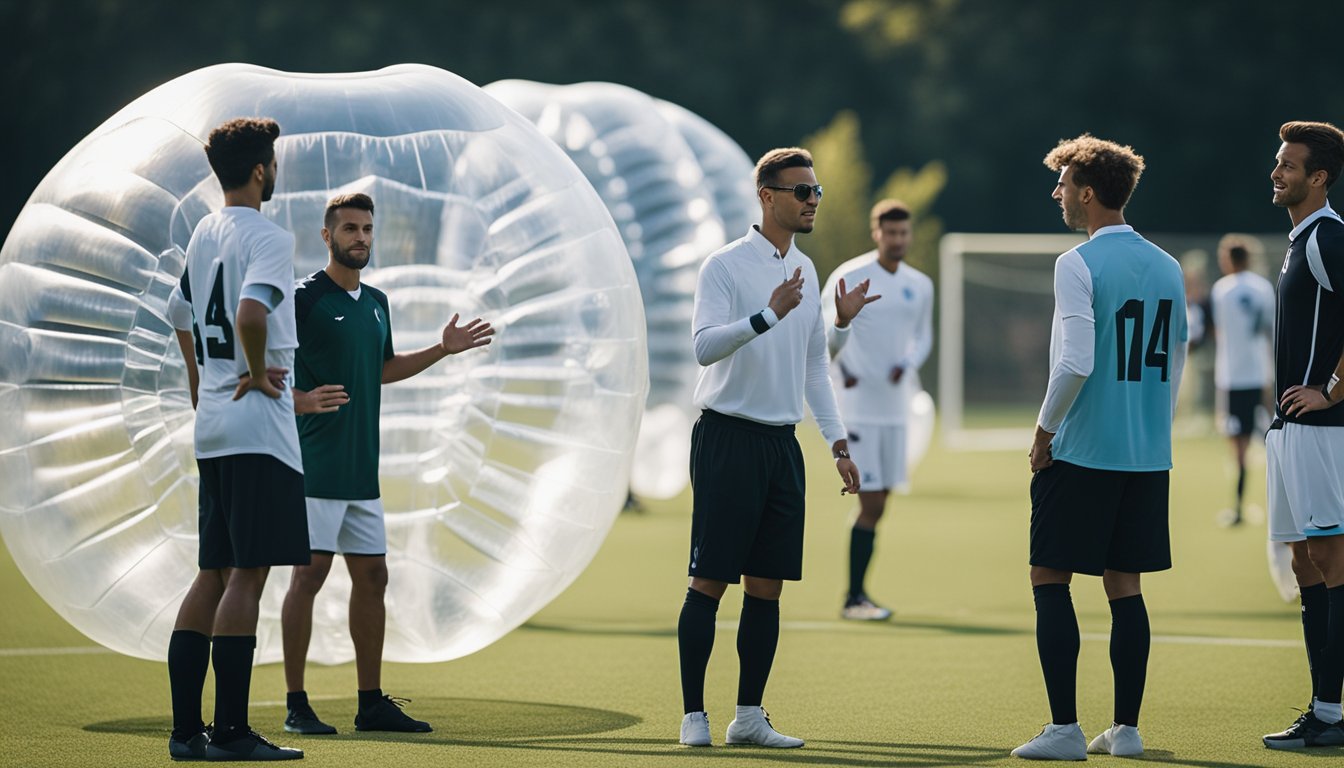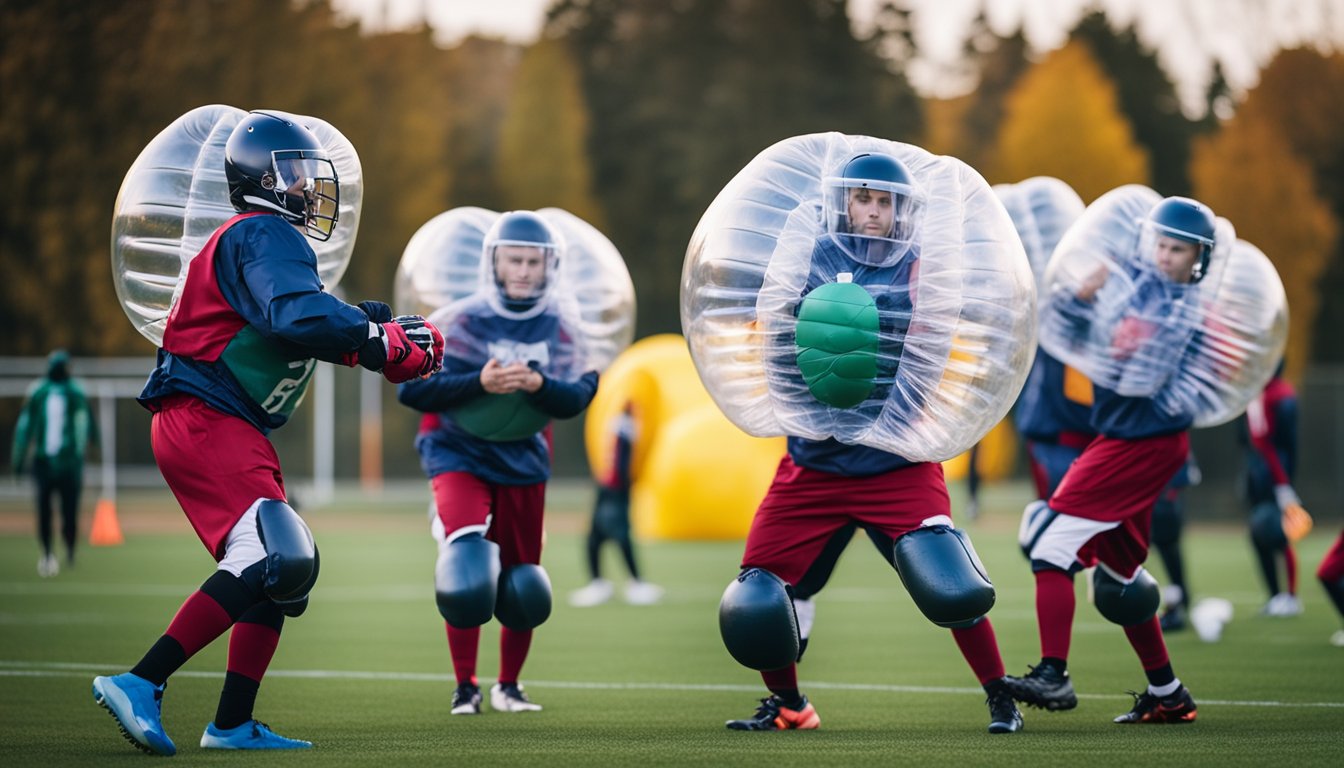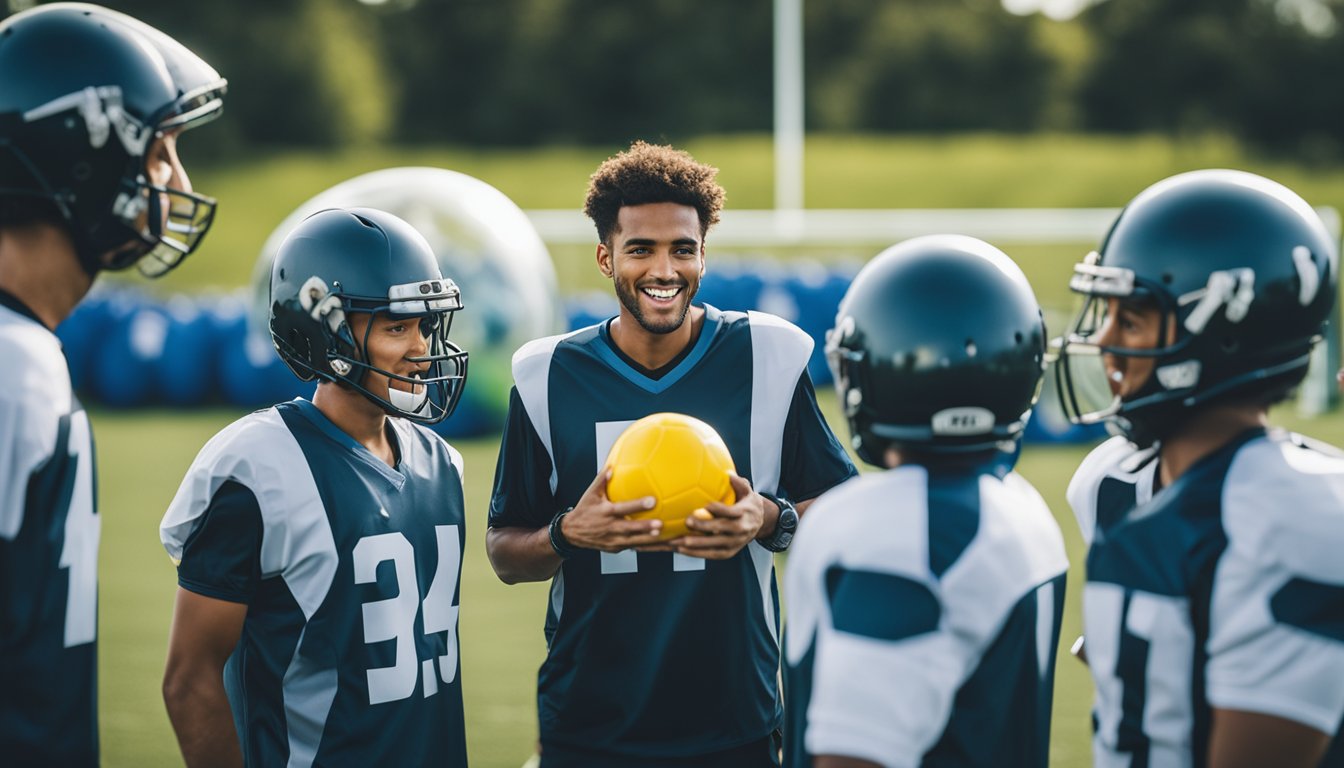Late updated: 07 May 2025 09:05
Written by: Emma Saunders
Bubble Football Strategies For Advanced Players: Mastering Tactical Play
For those of us who have moved beyond the basics in bubble football, advancing our skills involves mastering both offensive and defensive tactics to gain an edge over our opponents. Utilising agile movements and strategic physical play can dramatically alter the dynamics of a match. It's not just about speed or power; it's about leveraging unique strategies within the bubble itself to outmanoeuvre and outthink the opposing side.

As advanced players, developing specialist roles on the pitch can enhance our team's tactical execution. We can optimise player strengths by assigning roles that maximise both individual capabilities and team synergy. This approach involves meticulous planning and flexibility, allowing us to adapt quickly to different in-game scenarios.
Our journey in bubble football is about more than winning; it's about honing our ability to anticipate and respond to opponents' actions. By introducing sophisticated tactics and enhancing our agility, we elevate our game, making every match an opportunity to showcase skill and teamwork.
Key Takeaways
- Master agility and strategic physical play.
- Develop specialist roles to optimise team dynamics.
- Enhance adaptability through diverse tactics.
Key Advanced Bubble Football Strategies
In advanced bubble football, players need to execute dynamic attack patterns, sturdy defensive strategies, and swift counter-offensives. Mastering these techniques significantly influences gameplay outcomes.
Mixed Attack Patterns
In bubble football, it's critical that we adopt diverse attack patterns. Mixing running plays and pass plays prevents predictability, making it hard for opponents to counter our strategies. While a run-oriented team can aggressively push forward, incorporating pass strategies adds an element of surprise.
Coordinating between these two tactics is crucial. By faking a pass while setting up a run, we can catch defenders off guard. Agility and communication within the team are paramount. Precision in timing and swift decision-making ensures successful execution of mixed attacks, often resulting in scoring opportunities.
Defensive Positioning Techniques
Effective defensive strategies stem from solid positional awareness. Maintaining our formation and adapting to the opponent's moves is key. Staying low and strong provides better balance in the bubble. This helps us withstand physical challenges and hold our ground defensively.
Coverage is another cornerstone of defence. We need to close down spaces rapidly to intercept plays. Reacting promptly to opposition’s movements and positioning ourselves accordingly can disrupt their attacks. Teamwork becomes crucial here. By synchronising defensive efforts, we create a strong, impenetrable backline capable of resisting even the toughest offences.
Counter-Offensive Playbooks
Swift transitions from defence to attack are vital in bubble football. Our approach involves using quick breakouts as soon as we regain possession, quickly moving the ball towards the opponent's goal. Speed in executing these plays is vital, leveraging space left open by the opposition.
Utilising clear, planned playbooks aids in executing counter-offensives effectively. Identifying opportunities to exploit defensive gaps, we make swift, decisive plays to exploit these openings. Coordination and communication shine within these moments. By executing a well-oiled counter-offensive, we can swiftly turn defence into scoring opportunities, catching the opposition unprepared and unable to react in time.
Specialist Roles and Tactical Execution

Executing specialist roles in bubble football requires precise decision-making, dynamic movements, and adaptive strategies. Our focus in this section explores how players can excel by refining their unique roles, such as quarterbacks making quick, decisive choices, running backs utilising agile movements, and strategic blocking and blitzing techniques.
Quarterback Decision-Making
In bubble football, the quarterback remains a pivotal role, demanding quick and efficient decision-making skills. Our quarterbacks navigate high-pressure situations, focusing on maintaining ball control while scanning the field for deep pass opportunities. They assess the positions of cornerbacks and tight ends to orchestrate successful passing plays.
A good quarterback keeps defensive players guessing with unpredictable passes, reducing the chances of turnovers and sacks. They balance precise short passes with longer, deep threats to keep defences on their toes. Developing anticipation skills is critical for quarterbacks, enhancing their ability to make snap judgments that optimise offensive plays.
Dynamic Running Back Movements
Running backs in bubble football need to display agility and strategic movement. Their role involves dodging defenders using dynamic sprints and sudden directional changes. It's crucial for them to maintain balance and coordination, making them a key threat in our offensive design.
Running backs must also focus on durability, absorbing hits while avoiding turnovers. A strong running back exploits weaknesses in the defence, identifying gaps for potential big plays. Enhancing ball control and reducing fumbles are critical skills, which we refine through rigorous training sessions tailored to meet the demands of game situations.
Adaptive Blocking and Blitzing
Blocking and blitzing require adaptability in bubble football, with players understanding how to protect their quarterback and disrupt the opposing team's plays. Our blockers need to employ techniques that neutralise threats from effective pass rushers, using double-teams when necessary to secure the backfield.
Blitzing, an aggressive defensive strategy, calls for timing and precision. Properly executed blitzes pressure the offence, increasing chances for defensive turnovers and sacks. Understanding run defence is equally important, as our players need to switch rapidly between defending passes and blocking potential running threats. This dual approach enhances our defensive readiness and keeps opponents strategically unsettled.
Frequently Asked Questions

In our exploration of bubble football, safety, attire, team dynamics, and personal fitness are key elements that greatly influence performance and enjoyment. Here, we address common questions that can guide players towards a more secure and successful experience in this unique sport.
How can one minimise injury risks during a game of bubble football?
While bubble football is generally safe due to the protective Zorb bubbles, injuries can still happen. To reduce risks, it's important for players to adhere to rules, maintain proper hydration, and ensure their equipment is in good condition before playing. Good warm-up routines can also prepare the body and help prevent strains and sprains.
What attire is recommended for optimal movement and safety in bubble football?
Comfortable athletic wear is recommended. Well-fitted trainers with good traction are essential to prevent slipping on the playing surface. It's wise to avoid wearing jewellery or sharp objects that could puncture the bubble. Some players opt for lightweight knee pads for additional safety without sacrificing mobility.
Could you list the top advantages of participating in bubble football?
Bubble football offers numerous benefits, such as physical exercise, teamwork skills, and stress relief. It's a fun and engaging way to improve cardiovascular fitness while enjoying competitive play with friends or teammates. The sport also fosters camaraderie and strategic thinking, making it not only physically rewarding but also socially beneficial.
What tactics can significantly increase a team's winning potential in bubble football?
Success in bubble football often hinges on strategic positioning and coordination. Teams that focus on both offence and defence positions can control the field more effectively. Agile movement and low stances help maintain balance. Good footwork is crucial for maintaining possession of the ball and outmanoeuvring opponents.
How does team communication impact success in bubble football matches?
Efficient communication among team members can make or break a match. Clear, concise signals help coordinate offensive plays and defensive setups. Discussing strategies before the game and having a designated leader during play can ensure everyone is on the same wavelength, enhancing team synergy and performance.
What fitness components should players focus on to excel in bubble football?
Players should focus on cardio fitness, agility, and strength. Cardio helps maintain energy levels. Agility drills enhance quick changes in direction and speed, which are crucial during a match. Building core and leg strength improves balance and power, enabling players to handle the bubble suits effectively and maintain control on the field.
